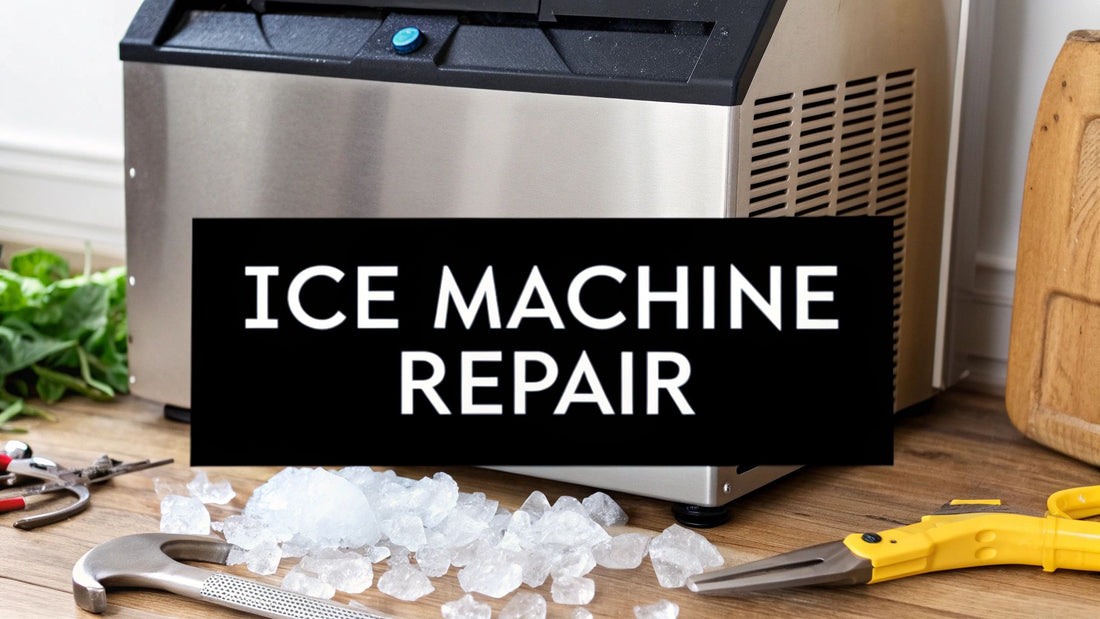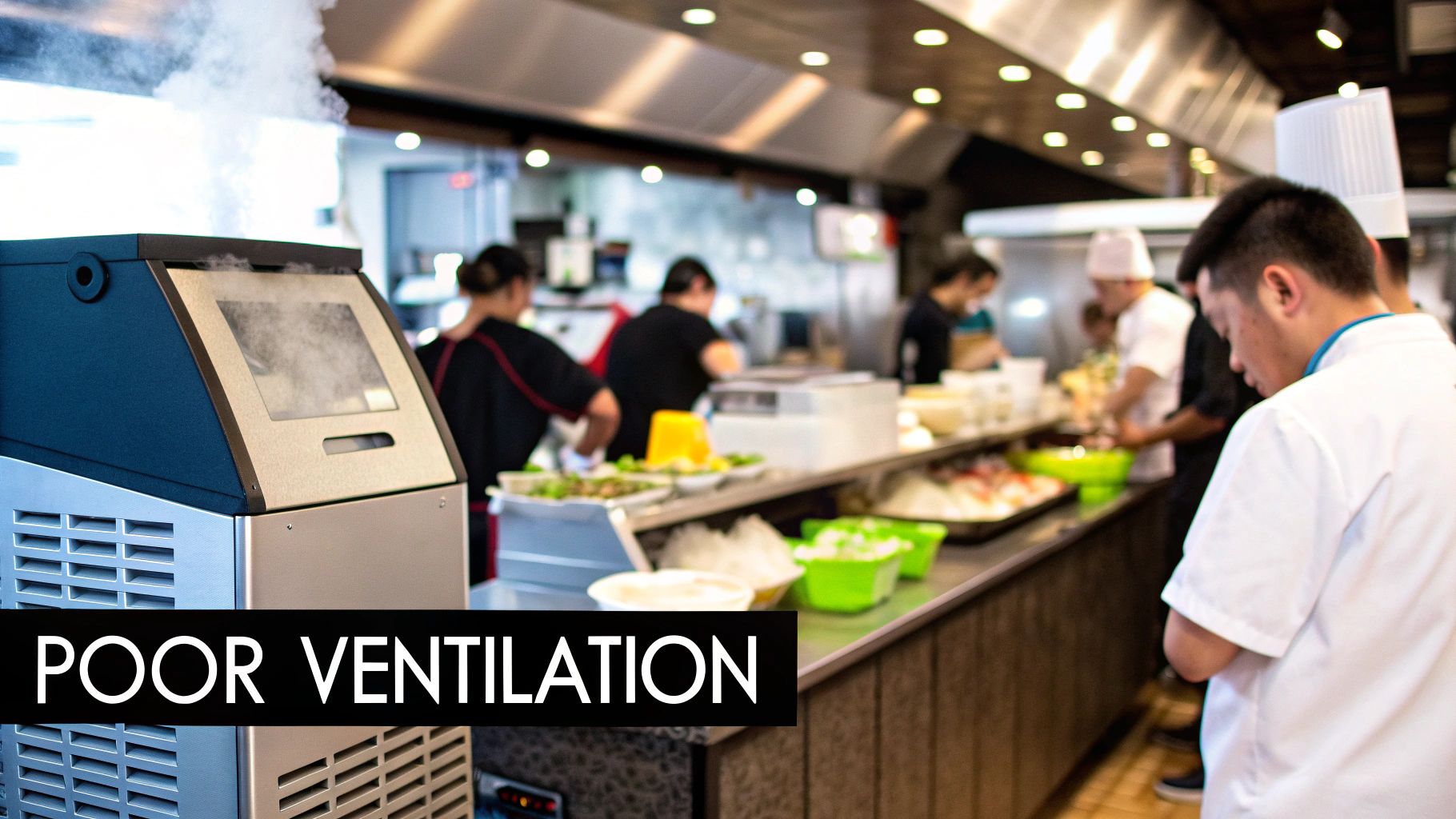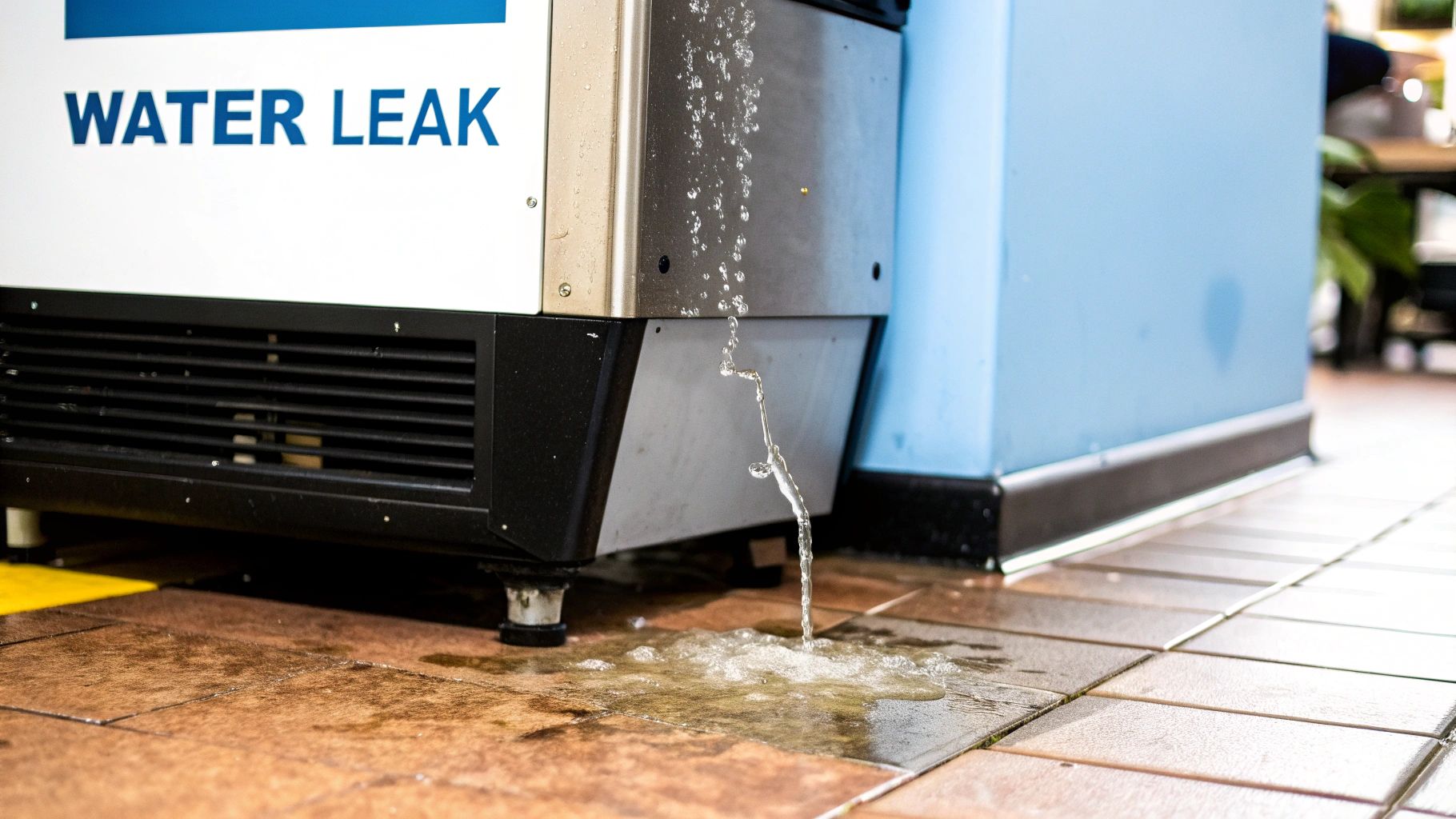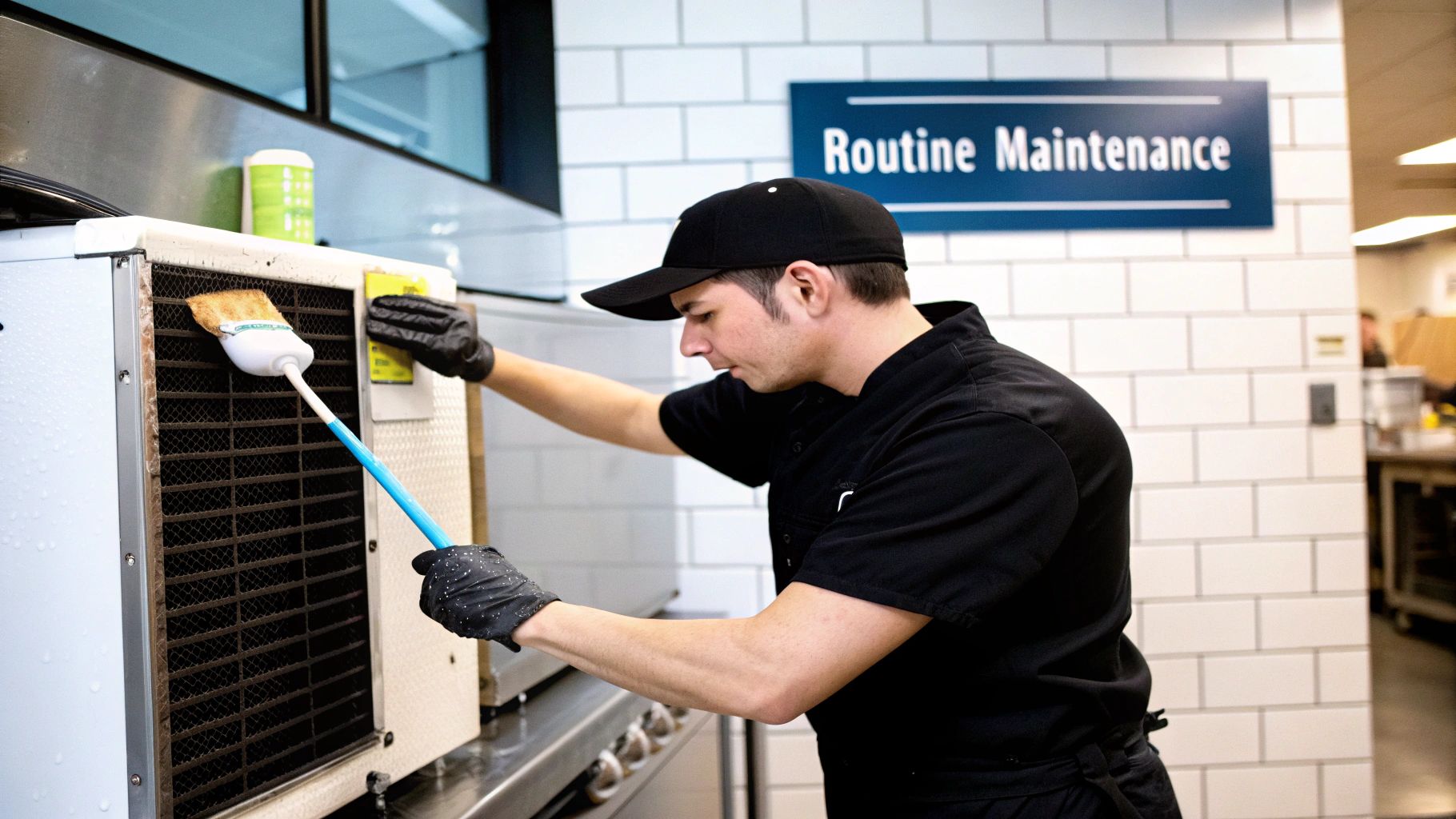
Commercial Ice Machine Troubleshooting Made Easy
Share
As a restaurant owner or chef, nothing sinks that feeling in the pit of your stomach faster than reaching into an empty ice bin during a busy service. When your commercial ice machine gives up, it feels like a crisis. But before you grab the phone for an emergency service call, take a deep breath. More often than not, the fix is something you can handle yourself in just a few minutes, getting you back to business without missing a beat.
The trick is to start with the obvious, even if it feels too simple. You'd be surprised how many "broken" machines are just unplugged or have a tripped breaker. Staying informed about your equipment is the first step toward a smoother operation.
Your First Steps When the Ice Machine Fails
Let’s walk through the initial triage. The goal here isn't to become a certified technician but to quickly rule out the simple stuff that costs you nothing to fix. This is about saving you that expensive service fee for a problem that was just a loose plug and getting you access to exclusive deals and insights that keep your kitchen profitable.
Start by checking the power source. Is the machine plugged in firmly? In the chaos of a busy kitchen, it's easy for cords to get bumped. After that, find your electrical panel and check the breaker for the ice machine. If it's tripped, flip it back on. If it trips again right away, then you know you have a bigger electrical issue that requires a pro.
Power and Water Supply Checks
Once you're sure the machine has power, shift your focus to the water. An ice machine is useless without it. Find the water line running to the back of the unit and follow it to the wall. Make sure the shut-off valve is turned all the way to the "on" position. Sometimes these get partially closed by accident, which is enough to choke the water flow and stop ice production cold.
While you're back there, give the water filter a look. A dirty, clogged filter is one of the top reasons we see for service calls. If it’s been more than a few months since it was last changed, it’s almost certainly restricting water flow and needs to be replaced.
This quick visual guide sums up the initial process perfectly.
Running through this simple power-and-water checklist will solve a huge number of common ice machine problems without ever needing to call for backup.
To help you narrow things down even faster, here's a quick reference table.
Quick Diagnostic Checklist for Common Ice Machine Failures
Use this checklist to quickly pinpoint the problem based on the symptoms your ice machine is showing.
| Symptom | Most Likely Cause | What to Check First |
|---|---|---|
| No power, no lights | Tripped breaker or unplugged | Breaker panel, power cord |
| Makes noise but no ice | No water supply | Water shut-off valve, clogged filter |
| Ice is small or cloudy | Clogged water filter or scale buildup | Water filter, signs of mineral scale |
| Machine is hot to the touch | Poor ventilation, dirty condenser | Air vents for clearance, condenser coils |
This table should get you started, but remember that some issues are more complex and may signal a deeper mechanical problem.
Assessing the Situation
You’ll find that a massive chunk of ice machine problems comes back to water. In fact, industry maintenance reports show that clogged filters and low water pressure account for roughly 25-30% of all service calls. It just goes to show how vital a clean, steady water supply is.
A critical but often overlooked factor is airflow. Ensure there are several inches of clearance around the machine's vents. Poor ventilation causes the compressor to overheat, drastically reducing ice production long before it fails completely.
Don't forget to consider where your machine lives. The best commercial kitchen design layout accounts for ambient heat. If your ice machine is right next to the fryer or a hot oven, it's going to struggle to stay cool and produce ice efficiently. If these initial checks don't get you back up and running, it's time to dig into more specific symptoms.
What to Do About Slow Production and Poor Ice Quality
When your ice machine starts falling behind during a busy shift, or the cubes come out looking small, cloudy, or slushy, you’ve got a problem. This isn't just about looks; it's a huge red flag for an efficiency issue that's hitting your bottom line through higher energy bills and unhappy customers. Staying on top of industry trends for restaurant equipment can help you diagnose these issues faster. Most of the time, the culprit isn't a massive mechanical failure but something much simpler: the machine's environment.
Your ice machine needs to breathe. Think about where it's located. Is it crammed next to a hot fryer or a convection oven? Is it tucked away in a stuffy, unventilated closet? That's a classic mistake. An air-cooled machine in a hot environment has to work overtime just to combat the ambient temperature. This constant battle can easily slash your daily ice output by 30-40%.

Check Your Airflow and Temperature
The first thing I always check is the machine's surroundings. Walk over to your unit and see how much space it has. You absolutely need at least six inches of clearance around all the vents. This isn't a suggestion—it's a requirement for the condenser to push hot air away from the machine.
If the unit feels hot to the touch or you can hear the fan running nonstop like it's trying to take off, it’s basically suffocating. Not only does this murder your ice production, but it also puts a tremendous strain on the compressor. Trust me, that's a repair bill you want to avoid at all costs.
The Hidden Impact of Water Quality
If the environment checks out, the next thing to look at is your water. Hard water is packed with minerals like calcium and magnesium, and over time, those minerals build up inside your machine. This gunk is called scale, and it loves to coat the evaporator plates—the very surface where your ice cubes are born.
Scale acts like a layer of insulation. It prevents the plates from getting cold enough, forcing the refrigeration system to run longer and harder. The result? You get undersized, misshapen cubes and a much slower harvest cycle. Sometimes, the issue is simply an insufficient water supply, which can be caused by low water pressure.
Expert Tip: I can't stress this enough—proper water filtration is non-negotiable for commercial ice machines. It’s the single best thing you can do to maintain efficiency and get that crystal-clear ice everyone wants.
Ignoring your water quality is a recipe for disaster. We see scale buildup on evaporator plates in roughly 30-35% of machines within just two years if they don't have proper filtration. That buildup can tank your ice production by a staggering 40-50%. On top of that, a dirty air-cooled condenser can drive up your energy consumption by as much as 15%.
The fix is straightforward: get a good commercial-grade water filter and stick to a strict replacement schedule. If you're already seeing cloudy ice or little white specks floating in your bin, that's a clear sign scale has taken hold. Tackling these environmental and water issues first will often get your machine back up to speed and improve your ice quality, no service call needed.
How to Fix Leaks and Water Flow Problems
Nothing ruins a manager’s day faster than seeing a puddle spreading out from underneath the commercial ice machine. It's more than just a slip hazard; it’s a flashing red light signaling a problem that needs your immediate attention. Pushing it off can lead to expensive water damage, wasted utilities, and a potential shutdown if the leak gets out of hand. For busy chefs and restaurant owners, this is one of those ice machine problems you just can't ignore.
So, where do you start? Your first move is to play detective and trace the water back to its source. Before you panic and assume a major component has failed, check the simple stuff first. More often than not, the culprit is something as basic as a loose water supply line or a cracked drain hose—especially in a busy kitchen where equipment gets jostled and bumped all day.

Pinpointing Common Leak Sources
If all the external connections are snug and dry, it's time to dig a little deeper. Two components are notorious for causing leaks and flow issues: the drain line and the water inlet valve. A clogged drain is incredibly common, usually thanks to slime or scale buildup that blocks water from leaving the machine. With nowhere to go, that water ends up on your floor.
The water inlet valve is another frequent offender. Think of it as the gatekeeper for all incoming water. If mineral buildup or simple wear and tear causes it to stick open, water will just keep flowing into the machine. It quickly overwhelms the system, and you've got a leak. Sometimes you can even hear a faint, constant trickling sound when this valve fails.
Let's break down the usual suspects.
- Clogged Drain Line: Check for obvious gunk where the line meets the floor drain. If you can, disconnect it and inspect for any internal blockage from scale or slime.
- Stuck Water Inlet Valve: Is water still running into the machine even when it's supposed to be off? The valve is almost certainly stuck open and will need to be replaced.
- Cracked Water Trough: This part's job is to spread water over the evaporator plate. A crack will cause water to spill out, either into the ice bin or directly onto the floor.
- Leaking Water Pump: The pump is the heart of the circulation system. If its seal fails, you'll see a slow but persistent drip coming from the pump's housing.
Addressing Restricted Water Flow
It's not just active leaks you have to worry about. Poor or restricted water flow can stop ice production in its tracks. A blocked distributor tube, for instance, won't let water flow evenly over the evaporator plate. This creates dry spots, which can either trip a safety sensor and shut the machine down or result in thin, useless sheets of ice.
A sneaky cause of "leaks" that often gets overlooked is a faulty bin control sensor or a stuck float valve. If the machine doesn't know the bin is full, it keeps trying to harvest, dumping water on top of an already full bin. The result? A messy overflow.
The good news is that nearly all of these water-related headaches are preventable. Your best weapon is a consistent cleaning and descaling schedule. Staying on top of mineral buildup is the key to stopping these failures before they can start, saving you from a major flood and ensuring you always have a steady supply of ice. Discovering the latest news on maintenance can give you an edge.
Understanding Electronic Controls and Sensor Errors
https://www.youtube.com/embed/L0f3P5NLahE
When your modern commercial ice machine starts flashing a cryptic error code, it's easy to feel a bit lost. These aren't the simple mechanical beasts of yesterday. Today’s machines are packed with sophisticated sensors and electronic control boards that manage every single part of the ice-making cycle. By staying informed about the latest trends in restaurant equipment, you'll be better prepared to troubleshoot these advanced systems.
Think of the electronic control board as the brain of the operation. It’s constantly taking in signals from a whole network of sensors. These sensors are the machine's eyes and ears, monitoring temperatures, ice thickness, and bin levels to keep everything running like clockwork. But when a sensor gets dirty or fails, it feeds bad information to the control board, causing shutdowns and all sorts of performance headaches.
Decoding Common Sensor Malfunctions
Two of the most common culprits you'll run into are the ice thickness probe and the bin thermostat.
The ice thickness probe is what tells the machine when the sheet of ice on the evaporator plate is thick enough to harvest. If this little probe gets caked in mineral scale—which happens all the time—it can't sense the ice properly. This can lead to paper-thin ice, ice sheets that are way too thick, or a machine that just gives up entirely.
Likewise, the bin thermostat (or sensor) is there to detect when the ice bin is full. Once it senses a full bin, it tells the machine to take a break. Now, picture a busy Saturday night. If a stray ice cube or some grime is blocking that sensor, the machine will think the bin is full and shut off, even when you're running dangerously low on ice.
A simple cleaning is often the quickest and most effective fix for sensor-related errors. Before you even think about a major electronic failure, grab a clean, damp cloth and a food-safe cleaner and carefully wipe down the ice thickness probe and bin sensors. This five-minute job can often save you a pricey service call.
From Simple Fixes to Calling a Pro
So, how do you tell the difference between a simple sensor cleaning and a more serious electronic problem? My advice is to always start with the basics. If a good cleaning doesn't clear the error code, the issue might be with the control board itself.
Here’s a practical way to think it through:
- The Error Code Won't Go Away: You've cleaned the sensors and reset the machine, but that same darn error code pops right back up. This is a strong hint that the control board could be faulty.
- The Machine is Unresponsive: Is the display panel completely dark or frozen, even though you know it has power? This often points to a failed main board.
- It's Acting erratically: If the machine is starting and stopping for no reason or cycling improperly, it's more likely an electronic issue than a mechanical one.
It’s an interesting shift in the industry. Recent data suggests that up to 40% of repairs on modern commercial ice machines are now related to electronic control malfunctions, a huge jump from the days of purely mechanical failures. As these machines get smarter, troubleshooting them often means dealing with complex electronics. You can learn more about these commercial ice machine trends to see where things are headed.
If you’ve done the basic checks and still suspect the control board, it's almost always time to call in a qualified technician. Trying to diagnose and replace a control board without the right training is a surefire way to cause more damage.
Proactive Maintenance to Prevent Future Breakdowns
The old saying, "an ounce of prevention is worth a pound of cure," couldn't be more true for commercial ice machines. The best way to deal with breakdowns is to stop them from ever happening. A consistent maintenance schedule is your number one defense against surprise failures, helping you get the most life out of your machine and ensuring a constant supply of clean, safe ice. For restaurant owners, this proactive approach is key to discovering exclusive deals on supplies and avoiding costly downtime.
This isn't about adding a bunch of complicated chores to your staff's already-long list. It's about building a few simple, smart habits into your kitchen's daily and weekly rhythm. Think of it as an investment that pays you back every single day by avoiding those panicked, expensive emergency service calls right in the middle of a dinner rush.

Building Your Maintenance Schedule
A good maintenance plan is one you'll actually stick to. You can break it down into quick daily, weekly, and monthly tasks. When your staff knows the schedule, they become the first line of defense in keeping the machine healthy.
Here’s a simple routine to get you started:
-
Daily Tasks (Takes less than 2 minutes):
- Give the outside of the machine a quick wipe-down. This stops dust and kitchen grease from building up and eventually finding its way inside.
- Check the ice scoop. Is it clean and in its proper sanitary holder? It should never be left in the ice bin, which is a fast track to contamination.
-
Weekly Tasks (About 10 minutes):
- Clean and sanitize the storage bin. You'll want to empty it out completely and use an approved cleaner to get rid of any slime or mold before it can get established.
- Take a look at the air filter. Pull it out and clean it. A dirty, clogged filter chokes off airflow and makes the compressor work way too hard, which can lead to overheating.
If you do only one thing, make it this: Change your water filter on a regular schedule. A good filter is your machine's only real defense against mineral scale, which is the silent killer of ice machines. Scale buildup chokes off water flow, ruins components, and tanks your machine's efficiency.
Key Maintenance Deep Dives
Beyond the quick check-ins, there are a couple of bigger jobs that need special attention. Cleaning the condenser coils and running a full cleaning and sanitizing cycle are non-negotiable.
Condenser coils, especially in a busy kitchen, get coated in a nasty mix of grease and dust. When they're dirty, they can't get rid of heat effectively. This forces your machine's refrigeration system into overdrive, which you'll see on your energy bill. More importantly, it puts a ton of strain on the compressor. At least twice a year, those coils need a deep cleaning with a stiff brush and a proper coil cleaning solution.
The other big one is a full internal cleaning. This is a two-step process that's vital for food safety. First, you run a scale remover through the system to dissolve all that mineral buildup. After that's flushed out, you run a food-grade sanitizer through to kill off any bacteria and slime. To make sure you're using the right stuff, you can find more information about the best ice machine cleaners and sanitizers for your specific unit.
For a deeper dive into how this kind of upkeep can protect all your kitchen equipment, check out these effective preventive maintenance strategies. Sticking to a maintenance plan is simply the best way to keep your ice machine out of trouble.
Got Questions About Ice Machine Care?
Even with a solid troubleshooting guide, you're bound to have questions. In the non-stop world of running a restaurant, getting a straight answer fast is what keeps your kitchen humming. Here are some of the most common things we get asked by chefs and owners about keeping their ice machines in top shape. We want to help you discover the latest news and get the best deals on your restaurant equipment and supplies.
Let’s skip the overly technical stuff and get right to the practical advice you can actually use.
How Often Do I Really Need Professional Servicing?
This is a big one, and the answer depends on your specific kitchen. While your team should be handling the daily and weekly cleanings, you absolutely need a qualified technician to give it a deep service at least twice a year.
This isn't just a simple wipe-down. A professional service is a whole different ballgame. The technician will:
- Descale and sanitize the entire water system, getting into all the nooks and crannies.
- Check refrigerant levels to make sure the machine is cooling efficiently.
- Inspect all the electrical components for safety and signs of wear.
- Clean out the tough spots, like the condenser coils.
Now, if you run a place with a lot of grease, flour, or yeast in the air—like a busy pizzeria or a bakery—you should bump that up to a quarterly service. All that airborne gunk clogs up filters and coils much faster, and ignoring it is a recipe for a major breakdown.
What's the Difference Between Cleaning and Sanitizing?
A huge one. And knowing the difference is non-negotiable for food safety. These two jobs are not the same, and you have to do both.
Cleaning is all about removing mineral buildup. You use a scale remover (which is a mild acid) to dissolve all that hard, crusty stuff that forms inside the machine's water system. Think of scale as a protective shield where bacteria love to hide.
Sanitizing is what actually kills the germs. You use a food-grade sanitizing solution to eliminate any bacteria, slime, or mold that's trying to make a home in the dark, damp parts of your machine.
Key Takeaway: You have to clean first, then sanitize. A sanitizer can't do its job if it can't get past a layer of mineral scale. This two-step process is the only way to make sure you’re serving safe, clean ice.
Can I Just Slap Any Old Water Filter on There?
Please don't. I know it's tempting to grab a generic filter from the hardware store to save a few bucks, but it's one of the most expensive mistakes you can make in the long run.
Your commercial ice machine needs a filter specifically designed for its high water volume. These specialized filters are built to handle a much heavier workload and do a better job of tackling the three biggest enemies of any ice machine:
- Scale: Those mineral deposits that are the number one cause of mechanical failures.
- Chlorine: The chemical that can make your ice taste and smell funky.
- Sediment: Tiny dirt and rust particles that clog up your machine's small valves and tubes.
Using the wrong filter can actually void your warranty and lead to the exact same costly repairs you were trying to avoid. Investing in the right filter isn't just an expense; it's a core part of a smart commercial kitchen equipment maintenance plan that protects your machine and your wallet.
At Encore Seattle Restaurant Equipment, we know that equipment you can count on is the heart of your operation. We offer a wide range of new and used commercial ice machines and have the expertise to help you keep them running perfectly. Explore our inventory and find the right solution for your kitchen at https://encoreseattle.com.
